Here is a wonderful short video about oystering in Long Island Sound from the Mystic Seaport Museum.
Farming the Sea: Oystering at Mystic Seaport
More information about oysters from the Mystic Seaport site:

Here is a wonderful short video about oystering in Long Island Sound from the Mystic Seaport Museum.
Farming the Sea: Oystering at Mystic Seaport
More information about oysters from the Mystic Seaport site:
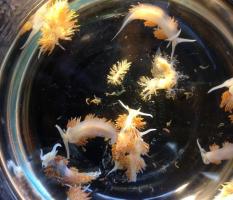
Marine sea slugs from a derelict Japanese vessel that washed ashore in Oregon. (John W. Chapman)
Since the Japanese tsunami of 2011 and the meltdown of the reactors at Fukushima, the Internet has been full of scary accounts of the Pacific Ocean becoming radioactive as well as stories of radioactive salmon and other fish. One widely repeated story said that Fukushima scientists have warned that fish in the Pacific Ocean will never again be safe for human consumption due to radioactive contamination. Another account claimed that radiation from the Fukushima disaster had caused 100% infant mortality among orca whales. There was even a story about mutated giant hornets from Fukushima killing people in Nebraska!
All of these accounts are urban legends, fake news — call them what you will — they are not true. Which is not to say that the US environment has not been impacted by the 2011 tsunami. A recent story in the Washinton Post describes how the tsunami brought a plethora of invasive species to the US West Coast, riding on the 5 million tons of debris swept into the ocean by the tsunami. Scientists have identified more than 280 species of organisms on the flotsam drifting ashore on the US West Coast.
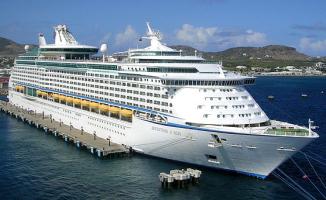 Royal Caribbean Cruise Line canceled their weekly scheduled cruise on the MV Adventure of the Seas and instead sent the 3,114 passenger ship on a relief mission to carry supplies to those in need and to evacuate people from islands devastated by Hurricane Maria. The ship called in San Juan, Puerto Rico on Wednesday and picked up 1,700 evacuees. The Adventure of the Seas arrived in St.Croix today to drop off supplies and pick up additional residents. It is expected to call in St. Thomas on Saturday to drop off supplies and pick up more evacuees before returning to Fort Lauderdale, arriving on October 3rd.
Royal Caribbean Cruise Line canceled their weekly scheduled cruise on the MV Adventure of the Seas and instead sent the 3,114 passenger ship on a relief mission to carry supplies to those in need and to evacuate people from islands devastated by Hurricane Maria. The ship called in San Juan, Puerto Rico on Wednesday and picked up 1,700 evacuees. The Adventure of the Seas arrived in St.Croix today to drop off supplies and pick up additional residents. It is expected to call in St. Thomas on Saturday to drop off supplies and pick up more evacuees before returning to Fort Lauderdale, arriving on October 3rd.
This is the second round of relief voyages for RCCL. The Adventure of the Seas and the Majesty of the Seas both evacuated residents from St. Maartin and St. Thomas in the aftermath of Hurricane Irma, earlier in the month.
For Throw-Back Thursday (TBT) here is a repost of an unlikely bit of history which we posted three years ago.
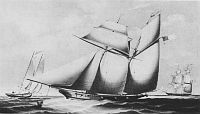 The schooner yacht Wanderer was built in 1857 for Colonel John D. Johnson, a New Orleans sugar baron. At just over 100 feet long, she was luxurious, sleek and extremely fast, reportedly capable of sailing at 20 knots. The Wanderer is not remembered, however, either for her beauty or her speed. She is remembered as the last slave ship to carry a human cargo to the shores of the United States.
The schooner yacht Wanderer was built in 1857 for Colonel John D. Johnson, a New Orleans sugar baron. At just over 100 feet long, she was luxurious, sleek and extremely fast, reportedly capable of sailing at 20 knots. The Wanderer is not remembered, however, either for her beauty or her speed. She is remembered as the last slave ship to carry a human cargo to the shores of the United States.
In her only voyage as a slaver, she flew the New York Yacht Club burgee at her peak. That turned out to be a critical detail. The burgee and the complete implausibility of a luxury yacht whose owner wore the uniform of the New York Yacht Club, operating as a slave ship, allowed the ship to slip past the American and British anti-slavery patrol on the African coast.
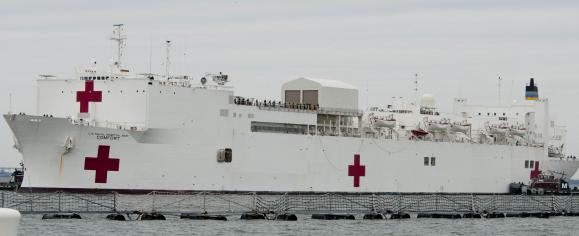
USNS Comfort, still In Norfolk, VA
The island of Puerto Rico was devastated by Hurricane Maria. The damage has been described as apocalyptic. Most of the island is without power or water and tens of thousands are in shelters or are homeless. The healthcare system is overwhelmed by the destruction. Both fuel and food are in short supply. Help is on the way, but is it enough?
There is widespread criticism that not enough is being done. The 3.4 million American citizens in Puerto Rico are in great need of help and yet are getting less support than the victims of recent hurricanes in Texas and Florida. The Washington Post quotes Adm. Paul Zukunft, the Coast Guard commandant, that he understands why Puerto Rico’s residents feel forgotten. “They feel isolated, and they’re probably getting a sense of betrayal, of, well, ‘Where is the cavalry?’ ” Zukunft said.
 The United States Coast Guard has set a new record for cocaine seizures at sea for the second year in a row. The Washington Post reports that the Coast Guard has seized more than 455,000 pounds of cocaine through Sept. 11 in the fiscal year that will end Oct. 1, breaking the record of 443,790 pounds set last year. About 85 percent of that comes from the eastern Pacific, service officials said. The Coast Guard also has detained at least 681 suspected smugglers in those operations, up from 585 last year and 503 in 2015.
The United States Coast Guard has set a new record for cocaine seizures at sea for the second year in a row. The Washington Post reports that the Coast Guard has seized more than 455,000 pounds of cocaine through Sept. 11 in the fiscal year that will end Oct. 1, breaking the record of 443,790 pounds set last year. About 85 percent of that comes from the eastern Pacific, service officials said. The Coast Guard also has detained at least 681 suspected smugglers in those operations, up from 585 last year and 503 in 2015.
While the Coast Guard has had record hauls of drugs seized on the high seas the past two years, that is not the case on land, according to data from Customs and Border Protection and Border Patrol reports the San Diego Union Tribune. Annual reports from those agencies, which are the main law enforcement authorities on the border, show a steady decline over the past several years in the amounts of drugs seized.
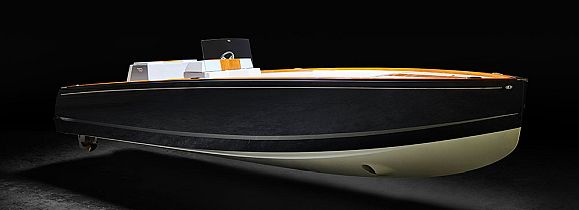 Hinckley Yachts claims to build “luxury yachts with innovative technology.” Their new 28’6″ fully electric runabout Dasher lives up to the boast. Fortune magazine referred to it as the “Tesla of luxury yachts.”
Hinckley Yachts claims to build “luxury yachts with innovative technology.” Their new 28’6″ fully electric runabout Dasher lives up to the boast. Fortune magazine referred to it as the “Tesla of luxury yachts.”
The new design, which uses carbon fiber to keep the boat light, features twin 80-horsepower Deep Blue 80i 1800 motors from German company Torqeedo, best known for its electric outboard motors. Two 40-kilowatt-hour BMW i3 lithium-ion batteries provide power to the motors.
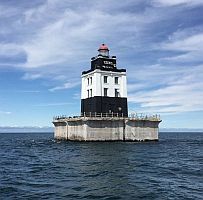 There are always iconic objects that are almost irresistible in contemplation. They represent ideas which are far too easy to fall in love with. I really wanted to own an old style Volkswagen “bug” and then I owned one and understood my mistake. The old bug had a nearly indestructible engine but the body of the car had almost entirely rusted away. It had seemed like a good idea at the time. Likewise, I had friends who were in love with the idea of converting an almost free surplus lifeboat into an oceangoing yacht. That didn’t work out too well either.
There are always iconic objects that are almost irresistible in contemplation. They represent ideas which are far too easy to fall in love with. I really wanted to own an old style Volkswagen “bug” and then I owned one and understood my mistake. The old bug had a nearly indestructible engine but the body of the car had almost entirely rusted away. It had seemed like a good idea at the time. Likewise, I had friends who were in love with the idea of converting an almost free surplus lifeboat into an oceangoing yacht. That didn’t work out too well either.
Another iconic structure, perhaps the most iconic, is a lighthouse. Every year the government puts decommissioned lighthouses up for sale, often for very little money. Some lighthouses have sold for as little as $10,000! A few have been given away for free! How cool is that? A lighthouse for less than the cost of a new car! If only that was all the lighthouses really cost.
The New York Times recently published an article, “True Cost of Buying a Cheap Lighthouse? That Should Be Visible a Mile Away” which looks at the real cost of owning a “cheap lighthouse.”
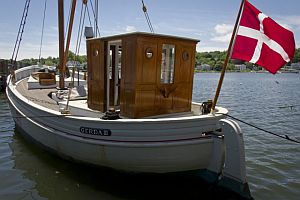 Among the fleet of ships and boats that make up the fleet at the Mystic Seaport Museum, the Danish lighthouse tender Gerda III, built in 1926, is a ruggedly attractive double-ender. Nevertheless, she could easily be overlooked. That would be a mistake. Gerda III played an important role in an audacious and risky rescue mission to save Jewish refugees from Denmark in 1943.
Among the fleet of ships and boats that make up the fleet at the Mystic Seaport Museum, the Danish lighthouse tender Gerda III, built in 1926, is a ruggedly attractive double-ender. Nevertheless, she could easily be overlooked. That would be a mistake. Gerda III played an important role in an audacious and risky rescue mission to save Jewish refugees from Denmark in 1943.
When it became apparent that the invading Germans intended to round up Danish Jews and send them to concentration camps, the Danes began a desperate effort to rescue the Jews. A flotilla of fishing and cargo vessels assembled to smuggle the refugees to safety in neutral Sweden. Gerda III was based in the fishing village of Gilleleje, only about 11 miles from Sweden. About one-fifth of the Danish Jews escaped to Sweden via Gilleleje.
In October of 1943, Hanny Sondig, the 19-year-old daughter of the boat’s manager, took command of Gerda III with a crew of four and nightly smuggled groups of 10 to 15 Jewish refugees in the tiny hold of the lighthouse tender. In the two-week evacuation, over 300 refugees were smuggled aboard Gerda III. Ultimately, more than 7,000 Jews were smuggled out of Demark. Only 481 were captured by the Germans and sent to camps.
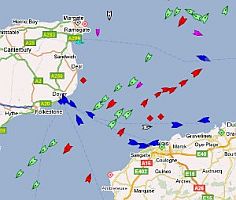 Following the recent collisions between US Navy destroyers and merchant ships, various internet sites posted the AIS tracks of the collisions. Well, they posted half the AIS tracks anyway. The merchant ships used AIS while the Navy did not. While US Navy ships have AIS transponders onboard they do not transmit their positions nor apparently do Navy crews regularly consult the receivers showing the location and course of other ships. It was possible to track merchant ships’ courses but not the destroyers’. That now appears to be about to change. The Navy appears ready to finally switch their AIS transmitters on.
Following the recent collisions between US Navy destroyers and merchant ships, various internet sites posted the AIS tracks of the collisions. Well, they posted half the AIS tracks anyway. The merchant ships used AIS while the Navy did not. While US Navy ships have AIS transponders onboard they do not transmit their positions nor apparently do Navy crews regularly consult the receivers showing the location and course of other ships. It was possible to track merchant ships’ courses but not the destroyers’. That now appears to be about to change. The Navy appears ready to finally switch their AIS transmitters on.
If the acronym AIS is not familiar, the Automatic Identification System (AIS) is an automatic tracking system which broadcasts a ship’s unique identification, position, course, and speed to other ships close by. AIS is required by the SOLAS (Safety of LIfe at Sea Convention) for almost all commercial ships. Use by military vessels is optional.
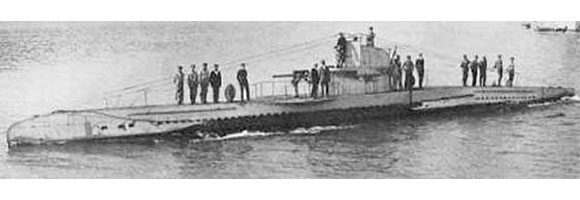
German type UBII Submarine
The almost intact wreck of a German submarine that sank during World War I has been located in the North Sea off Belgium, in 98 feet of water. The type UB-II submarine is said to be in good condition, with its hatches sealed, leading officials to believe that the bodies of the crew of up to 23 may still be inside the wreck. BBC quotes West Flanders Governor Carl Decaluwé saying, “The submarine is in such good condition that we reckon all the bodies are still on board.”
Here is a short video about the Kalmar Nyckel, a replica of Dutch built pinnace purchased by Sweden in the mid-1600s. What makes the Kalmar Nyckel so fascinating for me is that while there are a goodly number of 18th century replicas sailing today, actively sailing 17th century replicas are rare.
If you are interested in rigging, the Kalmar Nyckel is a particular treat. From her sprit-topsail that appears to balance precariously on the bow sprit, to the bonnets tied to the bottom of the sails, instead of reef points, there is much that would seem very strange even to an 18th or 19th century sailor. In addition to bunts and clewlines, the tall topsail and course are also furled by martinets, an intricate web of lines led to the long leeches. Add in the lateen mizzen and the whipstaff steering and the Kalmar Nyckel is an intriguing sailing vessel which is both familiar and an exotic relic of the past.
Kalmar Nyckel – A Tall Ship with a Broad Reach from Kalmar Nyckel Foundation on Vimeo.
 I will be participating in Jersey City’s 9th Annual Book Festival — Tales of Our Cities, in Van Vorst Park this Sunday. I will have a table with my books and books by other Old Salt Press authors starting at 11AM. I will be reading from my new novel, Evening Gray Morning Red at 3:30PM. I will also be giving away five Advance Reading Copies (ARCs) of the novel. Be sure to stop by and say hello if you are in the area.
I will be participating in Jersey City’s 9th Annual Book Festival — Tales of Our Cities, in Van Vorst Park this Sunday. I will have a table with my books and books by other Old Salt Press authors starting at 11AM. I will be reading from my new novel, Evening Gray Morning Red at 3:30PM. I will also be giving away five Advance Reading Copies (ARCs) of the novel. Be sure to stop by and say hello if you are in the area.
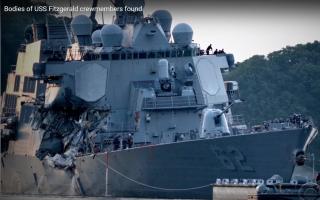 The fallout continues from the recent collisions with merchant ships in the Pacific involving the destroyers USS Fitgerald and the USS John McCain. The collisions resulted in the deaths of 17 US sailors. Earlier in the year, two guided missile cruisers based in the Pacific were also in casualties — one grounding and one collision — without loss of life.
The fallout continues from the recent collisions with merchant ships in the Pacific involving the destroyers USS Fitgerald and the USS John McCain. The collisions resulted in the deaths of 17 US sailors. Earlier in the year, two guided missile cruisers based in the Pacific were also in casualties — one grounding and one collision — without loss of life.
The Navy has announced the removal of Rear Adm. Charles Williams, commander of Combined Task Force 70, the Navy’s largest operational battle force. Also being removed is his subordinate, Captain Jeffery Bennett, commodore of Destroyer Squadron 15, the squadron. The Navy describes the actions as being part of “ongoing accountability actions as part of the Navy investigations.” Not directly related to the dismissals, the head of U.S. Naval Surface Forces Vice Adm. Tom Rowden put in a request last week to retire about two months early, several Navy officials confirmed to USNI News.
 My latest novel, Evening Gray Morning Red, will be published on October 15th in print and as an ebook. The Kindle ebook is available for pre-order on Amazon. About the novel:
My latest novel, Evening Gray Morning Red, will be published on October 15th in print and as an ebook. The Kindle ebook is available for pre-order on Amazon. About the novel:
In Evening Gray Morning Red, a young American sailor must escape his past and the clutches of the Royal Navy, in the turbulent years just before the American Revolutionary War.
In the spring of 1768, Thom Larkin, a 17-year-old sailor, newly arrived in Boston, is caught by a Royal Navy press gang and dragged off to HMS Romney, where he runs afoul of the cruel and corrupt Lieutenant Dudingston. Years later, after escaping the Romney, Thom again crosses paths with his old foe, now in command HMS Gaspee, cruising in Narragansett Bay. Thom Larkin must face the guns of the Royal Navy with only his wits, an unarmed packet boat, and a sandbar.
 Not all oil pollution is petroleum. Recently, there have been reports of strange yellow blobs washing up on the beaches of France’s Opal Coast. The blobs described variously as “foamy balls,” “strange spongelike clumps,” “yellow mousse” and “possibly the biggest balls of earwax ever,” have been identified as industrial paraffin. Some speculate that the blobs which cover roughly 30km of the coastline may be the result of tank cleaning by a ship which had a cargo of paraffin.
Not all oil pollution is petroleum. Recently, there have been reports of strange yellow blobs washing up on the beaches of France’s Opal Coast. The blobs described variously as “foamy balls,” “strange spongelike clumps,” “yellow mousse” and “possibly the biggest balls of earwax ever,” have been identified as industrial paraffin. Some speculate that the blobs which cover roughly 30km of the coastline may be the result of tank cleaning by a ship which had a cargo of paraffin.
Over the last few years, what have been referred to as “fatbergs,” congealed blocks of palm oil, have been washing ashore from time to time on British beaches of Sussex, Kent, Cornwall, Devon, Dorset and Hampshire. While, so far posing no threat to humans, the fatbergs have proven deadly to dogs. Dogs like the smell of the palm oil but chunks can get caught in their throats, causing them to choke. Also the blocks of weathered palm oil become a home for a wide range of bacteria and toxins.
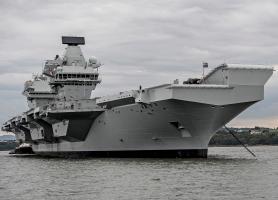 The UK’s latest and greatest new aircraft carrier, HMS Queen Elizabeth is driven not by nuclear power but by fossil fuels. Why is that? The Save the Royal Navy blog has an interesting analysis. Here are a few of the salient points:
The UK’s latest and greatest new aircraft carrier, HMS Queen Elizabeth is driven not by nuclear power but by fossil fuels. Why is that? The Save the Royal Navy blog has an interesting analysis. Here are a few of the salient points:
The biggest selling point for nuclear power is that a nuclear-powered ship only needs to be refueled once every 25 years, give or take. In the case of an aircraft carrier, however, the ship is not the only hardware which requires fuel.
As long as the aircraft on the ship are in use, they require lots and lots of fuel, so a Navy oiler is already part of the carrier battle group. And since most of the carrier battle group is also powered by fossil fuels, several Navy oilers are required.
As virtually every other ship and plane requires fuel oil, providing oil for the carrier is not that big a deal, especially as it is likely that the Royal Navy will be spending most of its time in the Atlantic, a smaller ocean, as compared to the Pacific, making replenishment that much easier.
Continue reading
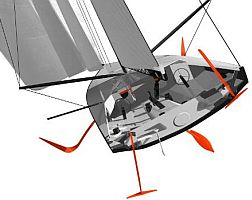
Volvo Ocean Concept Design
Almost two years ago, we raised the question — Are the new foiling Open 60 monohulls “the future of ocean racing or [are they] a foil too far?” The results of the Vendee Globe around-the-world, single-handed race last January may have answered that question. Armel Le Cléac’h crossed the finish line in France on January 19, 2017, winning in record time, sailing the foil-assisted IMOCA 60 Banque Populaire VIII. The next three finishers were also foil-assisted boats. The success of foiling monohulls in what is arguably the world’s toughest race may have changed the face of international racing.

Graphic: Washington Post
Hurricane Irma devasted islands in the Caribbean and did serious damage to cities in Florida. 6.5 million residents of Florida alone lost power and the damage toll is still being calculated across the state. The cities on the West Coast of Florida, particularly those on Tampa Bay, were damaged by high winds and rain but missed the predicted deadly storm surge when Irma jogged slightly eastward.
So far, the Tampa Bay area has been remarkably lucky with hurricanes. One day that luck may run out. When it does, the result won’t be pretty.
By luck, a quirk of geography, or perhaps both, no significant hurricane driven storm surge has hit the Tampa Bay area in almost 100 years. The cities of Tampa, St.Peterburg, and Clearwater are highly vulnerable to catastrophic flooding damage from a storm surge.
Recent studies have identified Tampa as the city most vulnerable to storm surge in the US, ahead of New Orleans. A study by the World Bank called Tampa Bay one of the 10 most at-risk areas on the globe. Fortunately, despite potentially dire projections, the storm surge from Irma in Tampa Bay and much of the rest of the West Coast of Florida was a manageable 2-4 feet. Continue reading
 Hurricane Irma absolutely devastated many islands in the Caribbean. Now, in the aftermath of the catastrophic storm, aid is being sent by a small armada of ships and boats from governments, corporations and private citizens.
Hurricane Irma absolutely devastated many islands in the Caribbean. Now, in the aftermath of the catastrophic storm, aid is being sent by a small armada of ships and boats from governments, corporations and private citizens.
The need for help is enormous. On the island of Barbuda, 90% of buildings have been damaged or destroyed and 50% of the population of about 1,000 people left homeless. Anguilla suffered major damage first from Hurricane Irma and then from Hurricane Jose, which followed close behind. Eleven people were killed, and more than 100 injured in the French overseas collectivities of St Martin and St Barthélemy (St Barts). 95% of the buildings on St. Martin were reported to be damaged or destroyed. Damage in the US Virgins Islands of St. Thomas and St. John was also extensive, as was damage to buildings in Tortola in the British Virgin Islands where a large sailboat charter fleet was also wiped out.